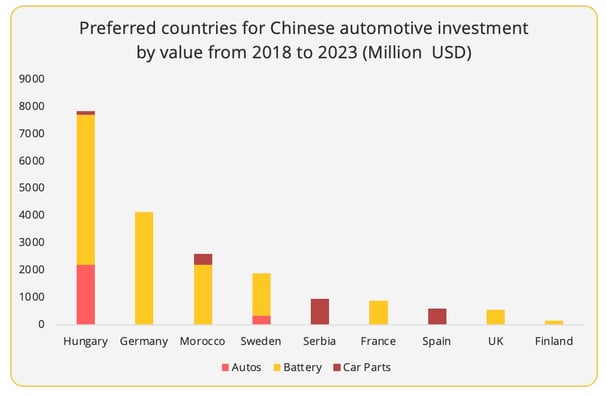The Complexities Of The Chinese Automotive Market: Case Studies Of BMW And Porsche

Table of Contents
The Unique Landscape of the Chinese Automotive Market
Market Size and Growth Potential
The sheer size of the Chinese automotive market is staggering. With a population exceeding 1.4 billion, a rapidly expanding middle class, and increasing urbanization, the demand for vehicles remains exceptionally high.
- Sales Figures: In recent years, China has consistently accounted for a significant portion of global automotive sales, often exceeding the combined sales of the US and European markets.
- Growth Projections: While growth rates may fluctuate, projections for the coming years still indicate a substantial market, fueled by continued economic development and government initiatives promoting electric vehicle adoption.
- Government Policies: Government regulations play a crucial role, impacting everything from fuel efficiency standards and emission controls to incentives for electric vehicle (EV) purchases and the development of charging infrastructure. These policies significantly influence market dynamics and require careful navigation by automakers.
Diverse Consumer Preferences and Segmentation
The Chinese automotive market isn't monolithic. Consumer preferences are incredibly diverse, reflecting regional variations, age demographics, and income levels.
- Consumer Segmentation: The market spans a wide spectrum, from budget-friendly compact cars targeting younger buyers to high-end luxury vehicles favored by affluent consumers in major cities. Rural markets have their own distinct needs and preferences.
- Brand Perception and Local Preferences: Brand image and reputation are paramount. Understanding local cultural nuances and adapting marketing strategies accordingly is crucial for success. Some brands resonate strongly with certain demographics while others struggle to gain traction.
- Influence of Social Media and Online Reviews: Online platforms and social media wield significant influence over consumer purchasing decisions in China. Negative reviews can quickly spread, damaging a brand's reputation, while positive feedback can drive sales.
BMW's Strategy in China: A Case Study in Localization and Adaptation
BMW's Market Penetration and Successes
BMW has established a strong presence in the Chinese automotive market, achieving significant market share through a strategic combination of localization and adaptation.
- Popular Models: BMW's success is partly attributed to the popularity of specific models tailored to Chinese consumer preferences, including SUVs and long-wheelbase versions of existing models offering increased rear passenger legroom.
- Localization Efforts: The company has invested heavily in localization efforts, adapting its marketing campaigns, vehicle designs (subtle modifications to suit aesthetic preferences), and even manufacturing processes to better resonate with the local market.
- Successful Partnerships: Collaborations with local suppliers and distributors have played a vital role in streamlining operations and enhancing market penetration.
BMW's Challenges and Adaptations
Despite its success, BMW has faced challenges in navigating the complexities of the Chinese automotive market.
- Competition: Intense competition from both established international brands and increasingly sophisticated domestic automakers demands constant innovation and adaptation.
- Supply Chain Issues: Maintaining a stable and efficient supply chain in a rapidly evolving market presents logistical hurdles, particularly in light of global disruptions.
- Navigating Regulations: Staying abreast of evolving regulations and ensuring compliance is essential to avoid penalties and maintain market access.
Porsche's Approach: Luxury Branding and Niche Market Dominance
Porsche's Niche Market Strategy in China
Porsche has focused on solidifying its position in the high-end luxury segment of the Chinese automotive market.
- Successful Models: Models like the Cayenne SUV and the 911 sports car have enjoyed considerable success, appealing to affluent Chinese consumers seeking high-performance vehicles and a prestigious brand image.
- Marketing and Branding: Porsche's marketing campaigns are carefully crafted to appeal to the aspirational aspects of luxury car ownership, emphasizing exclusivity and performance.
- Brand Exclusivity: Maintaining brand exclusivity is a key strategy. Porsche carefully manages its production and distribution to avoid diluting its brand image.
Challenges and Opportunities for Porsche's Luxury Positioning
While Porsche's luxury positioning has proven successful, the company faces challenges in maintaining its dominance.
- Competition from Other Luxury Brands: Competition from other established luxury brands and emerging domestic luxury automakers is fierce.
- Growth of Domestic Luxury Brands: The rise of high-quality domestic luxury brands poses a growing threat to established international players.
- Electric Vehicle Revolution: The transition towards electric vehicles presents both opportunities and challenges. Porsche needs to successfully integrate electric models into its lineup while preserving its brand identity.
Conclusion: Unraveling the Intricacies of the Chinese Automotive Market – A Call to Action
The Chinese automotive market presents a complex tapestry of opportunities and challenges. BMW and Porsche's contrasting strategies highlight the need for adaptability and a deep understanding of local consumer preferences, government regulations, and competitive dynamics. The sheer size and growth potential of the Chinese automotive market remain undeniable, but success requires a nuanced approach that goes beyond simply translating marketing materials. Dive deeper into understanding the nuances of the Chinese automotive market; learn more about the strategies needed to thrive in the competitive landscape of the Chinese automotive market to unlock its vast potential. Thorough market research and a commitment to localization are crucial for any automaker aiming to succeed in this dynamic and ever-evolving environment.

Featured Posts
-
 The Phoenician Scheme Analyzing Wes Andersons Cannes Film
May 28, 2025
The Phoenician Scheme Analyzing Wes Andersons Cannes Film
May 28, 2025 -
 Young Man Utd Fan Left Disheartened By Garnacho
May 28, 2025
Young Man Utd Fan Left Disheartened By Garnacho
May 28, 2025 -
 Marlins 3 1 Win Over Cubs Stowers Two Home Runs Weathers Solid Performance
May 28, 2025
Marlins 3 1 Win Over Cubs Stowers Two Home Runs Weathers Solid Performance
May 28, 2025 -
 Ryan Reynolds Faces Backlash Justin Baldonis Lawyer Refuses To Back Down
May 28, 2025
Ryan Reynolds Faces Backlash Justin Baldonis Lawyer Refuses To Back Down
May 28, 2025 -
 Prakiraan Cuaca Besok 24 April 2024 Di Jawa Tengah Waspada Hujan Sore
May 28, 2025
Prakiraan Cuaca Besok 24 April 2024 Di Jawa Tengah Waspada Hujan Sore
May 28, 2025
